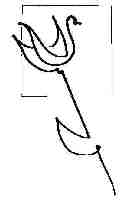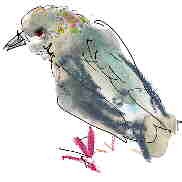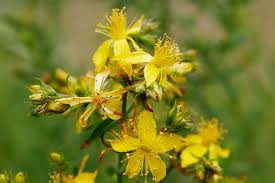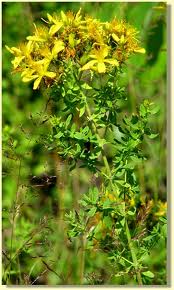|
Norman
Allan | ||||
 |
Dr. Norman Allan's Vol
6, No. 6, |  |
|
*
St.
Johnswort | Dr.
Allan is available on the Danforth (by appointment) and at 2 College on Wednesdays. phone 416 928 9272 | |
I
recently saw a young patient recovering from a stroke; thought of St. Johnswort,
a healer for the nervous system: spoke to Michael Vertolli, who thought it might
be appropriate, and thought I'd review St. Johnswort here... | ||
|---|---|---|
St Johnswort Hypericum perforatum St. Johnswort is a nervine relaxant (mild sedative), anti-depressant,
general vulnerary (wound healer), nervine vulnerary, astringent, and styptic (stops
bleeding). Cautions!
Note though that 10% of people find St. Johnswort sedative Contraindications: Michael Vertolli says that while he knows of no official contraindications he "would not recommend prolonged use of St. Johnswort during pregnancy."
St. Johnswort cause the production of an enzyme, PXR, which causes the production of a cytochrome P450 (which is a major detox vehicle) that gets rid of "xenobiotics"(i.e. unnatural chemicals): it increases the metabolism of the detox system. |
| |
| * * * | ||
My understanding
is that apple seed contain "amygdalin" (AKA"laetrile"), a
very controversial substance found in higher consentration in wild apricots. Many
of us counter culture types have believed that wild apricot seeds and apple seeds
protect against cancer. Apple
seeds? Apricot seeds? I am not sure that this has been well researched. One the
one hand, as stated above, I've heard many advoate the moderate injestion of these
seed (6 apricot seeds I believe was the number per day, we would take at one sitting
the 1970s in our macrobiotic household). On the other hand, I just heard a story
{urban myth?} about someone who horded apple seed and then took an enormous dose,
a bottleful, and died (so the story went). Ah, but the orthodocs say that laetrile is useless, the other piece of the controversy, and hereby hangs a story worth telling... Ralph
Moss graduate in classics (or English - this is my meory of the story for
a while ago) and went to work for Sloan-Kettering (S-K) in 1972 as a publicist.
At S-K he met an old researcher, Japanese, who had done some work on laetruile
at S-K. The research showed that laetrile would stop the metastisis (the spreading)
of breast cancer in mice! | ||
| * * * | ||
| and from my last newsletter (cause this one is so thin) | ||
| * * * | ||
Probiotics Elevate Mood A recent study seems to show that acidophilus might elevate mood. "For 28 days, the mice were fed the probiotic Lactobacillus rhamnosus JB-1. The study, which was published this week in the Proceedings of the National Academy of Sciences, found that the probiotics affected neurotransmitter receptors, altering brain activity in the hippocampus, amygdala and prefrontal cortex. These are areas of the brain associated with mood. As well, the mice had less of the stress hormone corticosterone in their blood."(source: Toronto Star) The researchers explanation is "a reach", but is interesting in its own right. "The findings suggest that changes in the gastrointestinal tract are communicated to the central nervous system via the vagus nerve, a long cranial nerve that extends from the brain to the abdomen. The discovery of this pathway is particularly significant Bienenstock said, explaining that electrical stimulation of the vagus nerve in humans has been shown to improve difficult-to-treat depression." | ||
| * * * | ||
Fish Oil, Plant Omega 3s, and Cardiovascular Health The is some evidence that fish "omega 3"oils are beneficial to cardiovascular health. Less evidence that plant source "omega 3" has the same value. (Note: there are three types of "omega 3" or "n-3 fatty acids": two from fish - eicosapentaenoic acid (EPA) and docosahexaenoic acid (DHA) - and one from plant sources - a-linolenic acid (ALA) found in walnuts, flax seeds and chia seeds. Is there more (though controversial) evidence for fish (EPA and DHA) than for plant ALA because there's been more research? Probably. Wikipedia says, "The 18 carbon [ALA] has not been shown to have the same cardiovascular benefits as DHA or EPA." Note, they say "has not been shown to," and not "has been shown not to." One of the studies I've found (on-line) found that an experimental walnut diet lowered total cholesterol and LDL cholesterol concentrations, while a fish diet resulted in decreased serum triglyceride and increased HDL-cholesterol concentrations. So both are valuable and may complement each other. (Though another author says that there is no data on the potential therapeutic benefit of EPA, DHA, or ALA supplementation on those individuals who already consume a vegetarian diet.) So, there just hasn't been that much research and so many authors are hedging there bets: "Observational data suggest that diets rich in EPA, DHA, or ALA do reduce cardiovascular events, including myocardial infarction and sudden cardiac death; however, randomized controlled trial data are somewhat less clear;" and "…The evidence [for plant sources, alpha-linolenic acid] is not as compelling as for fish oil." I'm a cardiac patient,
and I'm a vegetarian, and for now I'm just eating a lot of flax (freshly ground),
chia, and walnuts. | flax 
| |
| * * * | ||
 |
|
Dr. Allan's Newsletter: May, 2012: snippets from newspapers which I hope are of interest Dr.
Allan's Newsletter: Mar, 2010: as
above Dr. Allan's Newsletter: April 2009: snippets from newspapers which I hope are of interest. Dr. Allan's Newsletter: Oct. 2008: as above Dr. Allan's Newsletter: Aug 2008: Dr. Allan's Newsletter: June 2008: Dr. Allan's Newsletter: May 2008: Dr. Allan's Newsletter: Apr 2008: Dr. Allan's Newsletter: Oct 2007: Dr. Allan's Newsletter: Sept 2007: Dr. Allan's Newsletter: July 2007: Dr. Allan's Newsletter, Spring 2007: Dr. Allan's Newsletter, Winter 2007: Dr. Norman Allan's Newsletter, May 2006: Dr. Norman Allan's Newsletter, April 2006: Dr. Norman Allan's Newsletter, March 2006: Dr. Norman Allan's Newsletter, February 2006: Dr. Norman Allan's Newsletter, January 2006: Dr. Norman Allan's Newsletter, December 2005: Dr. Norman Allan's Newsletter, November: 2005 Dr. Norman Allan's Newsletter, October: 2005 Dr. Norman Allan's Newsletter, August/September: 2005 Dr. Norman Allan's Newsletter, June/July 2005: Dr. Norman Allan's Newsletter, May 2005: Dr. Norman Allan's Newsletter, March/April 2005: an essay on immune tonics published in "Healthy Directions" - and snippets from newspapers, various, which I hope are of interest. Dr.
Norman Allan's Newsletter, February 2005: snippets from newspapers, various,
which I hope are of interest - and a discussion of "C Reactive Protein"
as an indicator of risk for heart disease. |
|---|
|
From vol 3 no 1: An interesting clipping that
I've stumbled on since the last letter concerns vibration:(Globe and Mail, 13
June 2006) "SCIENTIST GETS VIBES TO BUILD BONES. Device to help space travelers
approved to treat sufferers of osteoporosis." The device is a machine that
generates vibrations - vibration implies acceleration/deceleration, and is therefore
somewhat like gravity - therefore in theory, and it seems in practice, good for
maintenance of bone mass in zero gravity (it was designed for use in space). On
earth, the article says, "a person who stands on [the platform of the vibration
device] for 20 minutes a day can build bone density an average of 2 percent a
year. ... By sending small vibrations through the body - moving about 50 micrometers
(or the thickness of a few human hairs) up and down and repeating at a rate of
34 cycles per second - the platform triggers musculoskeletal stimulations that
naturally occur... the vibrations from the platform are set to a frequency that
[generates acceleration that] is one-third that of gravity... and is therefore
safe. Other devices (exercise machines) which generate 4 to 15 gravities are dangerous,
we are told. The thing that I find interesting here is that a relatively subtle vibration is having an appreciable (positive) effect on body metabolism and function. I am therefore wondering what the vibrational effects of chanting, OM, for instance, are? We'd need an engineer to tell us about the difference in order of magnitude between that devise and the vibrations that are set up in your body by, a) a rock band in a bar, b) by chanting, OM for instance. However, orders of magnitude might or might not be of relevance here. Subtle vibrations may be having physiological effects. One would have to look and see. Meanwhile, the safe course would be to do the chanting. It's bound to have salubrious effects at many levels (if not bone mass and muscle mass - muscles, that too was in the article). ("Salubrious" = health promoting - forgive the use of a relatively obscure word.) "Over all the bone density of the controlled group (the reporter has got this wrong - he means "experimental group" as compared to the control group) increased by 3 percent during a year, and muscle mass improved by 4 percent." So
get chanting, OM (or what you fancy). |

